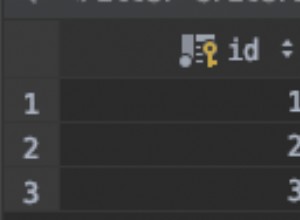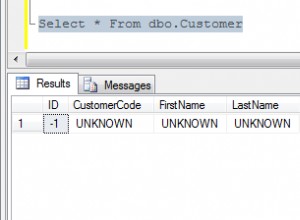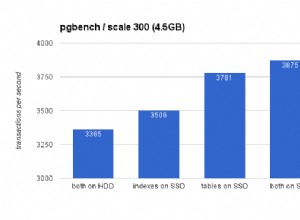La query seguente ti consentirà di aprire qualsiasi percorso (o set di percorsi) sfruttando la clausola have di SQL e group_concat funzione.
Quella che segue è la definizione della tabella e i dati di esempio che ho usato:
drop table nested_set;
CREATE TABLE nested_set (
id INT,
name VARCHAR(20) NOT NULL,
lft INT NOT NULL,
rgt INT NOT NULL
);
INSERT INTO nested_set (id, name, lft, rgt) VALUES (1,'HEAD',1,28);
INSERT INTO nested_set (id, name, lft, rgt) VALUES (2,'A',2,3);
INSERT INTO nested_set (id, name, lft, rgt) VALUES (3,'B',4,17);
INSERT INTO nested_set (id, name, lft, rgt) VALUES (4,'B1',5,10);
INSERT INTO nested_set (id, name, lft, rgt) VALUES (5,'B1.1',6,7);
INSERT INTO nested_set (id, name, lft, rgt) VALUES (6,'B1.2',8,9);
INSERT INTO nested_set (id, name, lft, rgt) VALUES (7,'B2',11,16);
INSERT INTO nested_set (id, name, lft, rgt) VALUES (8,'B2.1',12,13);
INSERT INTO nested_set (id, name, lft, rgt) VALUES (9,'B2.2',14,15);
INSERT INTO nested_set (id, name, lft, rgt) VALUES (10,'C',18,25);
INSERT INTO nested_set (id, name, lft, rgt) VALUES (11,'C1',19,20);
INSERT INTO nested_set (id, name, lft, rgt) VALUES (12,'C2',21,22);
INSERT INTO nested_set (id, name, lft, rgt) VALUES (13,'C3',23,24);
INSERT INTO nested_set (id, name, lft, rgt) VALUES (14,'D',26,27);
La seguente query fornisce l'intero albero (tranne HEAD):
SELECT
node.id
, node.lft
, node.rgt
, node.name
, GROUP_CONCAT(parent.name ORDER BY parent.lft SEPARATOR "/" ) AS path
, (COUNT(parent.lft) - 1) AS depth
FROM nested_set AS node
inner join nested_set AS parent
on node.lft BETWEEN parent.lft AND parent.rgt
where parent.lft > 1
GROUP BY node.id
Con un output di quanto segue quando eseguito sui dati di esempio:
+------+-----+-----+------+-----------+-------+
| id | lft | rgt | name | path | depth |
+------+-----+-----+------+-----------+-------+
| 2 | 2 | 3 | A | A | 0 |
| 3 | 4 | 17 | B | B | 0 |
| 4 | 5 | 10 | B1 | B/B1 | 1 |
| 5 | 6 | 7 | B1.1 | B/B1/B1.1 | 2 |
| 6 | 8 | 9 | B1.2 | B/B1/B1.2 | 2 |
| 7 | 11 | 16 | B2 | B/B2 | 1 |
| 8 | 12 | 13 | B2.1 | B/B2/B2.1 | 2 |
| 9 | 14 | 15 | B2.2 | B/B2/B2.2 | 2 |
| 10 | 18 | 25 | C | C | 0 |
| 11 | 19 | 20 | C1 | C/C1 | 1 |
| 12 | 21 | 22 | C2 | C/C2 | 1 |
| 13 | 23 | 24 | C3 | C/C3 | 1 |
| 14 | 26 | 27 | D | D | 0 |
+------+-----+-----+------+-----------+-------+
Le seguenti aggiunte alla query precedente ti daranno il controllo necessario per aprire le varie sezioni:
having
depth = 0
or ('<PATH_TO_OPEN>' = left(path, length('<PATH_TO_OPEN>'))
and depth = length('<PATH_TO_OPEN>') - length(replace('<PATH_TO_OPEN>', '/', '')) + 1)
La clausola having applica filtri ai risultati del gruppo per query. La parte "profondità =0" serve per garantire di avere sempre i nodi del menu di base (A, B, C e D). La parte successiva è la parte che controlla quali nodi sono aperti. Confronta il percorso dei nodi con un percorso impostato che si desidera aprire ('') per vedere se corrisponde e si assicura anche che si apra solo di livello nel percorso. L'intera o la sezione con la logica '' può essere duplicata e aggiunta secondo necessità per aprire più percorsi secondo necessità. Assicurati che '' non termini con una barra finale (/).
Di seguito sono riportati alcuni esempi di output per mostrarti come costruiresti le query per ottenere gli output desiderati:
=========Open B==========
SELECT
node.id
, node.lft
, node.rgt
, node.name
, GROUP_CONCAT(parent.name ORDER BY parent.lft SEPARATOR "/" ) AS path
, (COUNT(parent.lft) - 1) AS depth
FROM nested_set AS node
inner join nested_set AS parent
on node.lft BETWEEN parent.lft AND parent.rgt
where parent.lft > 1
GROUP BY node.id
having
depth = 0
or ('B' = left(path, length('B'))
and depth = length('B') - length(replace('B', '/', '')) + 1)
+------+-----+-----+------+------+-------+
| id | lft | rgt | name | path | depth |
+------+-----+-----+------+------+-------+
| 2 | 2 | 3 | A | A | 0 |
| 3 | 4 | 17 | B | B | 0 |
| 4 | 5 | 10 | B1 | B/B1 | 1 |
| 7 | 11 | 16 | B2 | B/B2 | 1 |
| 10 | 18 | 25 | C | C | 0 |
| 14 | 26 | 27 | D | D | 0 |
+------+-----+-----+------+------+-------+
=========Open B and B/B1==========
SELECT
node.id
, node.lft
, node.rgt
, node.name
, GROUP_CONCAT(parent.name ORDER BY parent.lft SEPARATOR "/" ) AS path
, (COUNT(parent.lft) - 1) AS depth
FROM nested_set AS node
inner join nested_set AS parent
on node.lft BETWEEN parent.lft AND parent.rgt
where parent.lft > 1
GROUP BY node.id
having
depth = 0
or ('B' = left(path, length('B'))
and depth = length('B') - length(replace('B', '/', '')) + 1)
or ('B/B1' = left(path, length('B/B1'))
and depth = length('B/B1') - length(replace('B/B1', '/', '')) + 1)
+------+-----+-----+------+-----------+-------+
| id | lft | rgt | name | path | depth |
+------+-----+-----+------+-----------+-------+
| 2 | 2 | 3 | A | A | 0 |
| 3 | 4 | 17 | B | B | 0 |
| 4 | 5 | 10 | B1 | B/B1 | 1 |
| 5 | 6 | 7 | B1.1 | B/B1/B1.1 | 2 |
| 6 | 8 | 9 | B1.2 | B/B1/B1.2 | 2 |
| 7 | 11 | 16 | B2 | B/B2 | 1 |
| 10 | 18 | 25 | C | C | 0 |
| 14 | 26 | 27 | D | D | 0 |
+------+-----+-----+------+-----------+-------+
=========Open B and B/B1 and C==========
SELECT
node.id
, node.lft
, node.rgt
, node.name
, GROUP_CONCAT(parent.name ORDER BY parent.lft SEPARATOR "/" ) AS path
, (COUNT(parent.lft) - 1) AS depth
FROM nested_set AS node
inner join nested_set AS parent
on node.lft BETWEEN parent.lft AND parent.rgt
where parent.lft > 1
GROUP BY node.id
having
depth = 0
or ('B' = left(path, length('B'))
and depth = length('B') - length(replace('B', '/', '')) + 1)
or ('B/B1' = left(path, length('B/B1'))
and depth = length('B/B1') - length(replace('B/B1', '/', '')) + 1)
or ('C' = left(path, length('C'))
and depth = length('C') - length(replace('C', '/', '')) + 1)
+------+-----+-----+------+-----------+-------+
| id | lft | rgt | name | path | depth |
+------+-----+-----+------+-----------+-------+
| 2 | 2 | 3 | A | A | 0 |
| 3 | 4 | 17 | B | B | 0 |
| 4 | 5 | 10 | B1 | B/B1 | 1 |
| 5 | 6 | 7 | B1.1 | B/B1/B1.1 | 2 |
| 6 | 8 | 9 | B1.2 | B/B1/B1.2 | 2 |
| 7 | 11 | 16 | B2 | B/B2 | 1 |
| 10 | 18 | 25 | C | C | 0 |
| 11 | 19 | 20 | C1 | C/C1 | 1 |
| 12 | 21 | 22 | C2 | C/C2 | 1 |
| 13 | 23 | 24 | C3 | C/C3 | 1 |
| 14 | 26 | 27 | D | D | 0 |
+------+-----+-----+------+-----------+-------+
Questo è tutto. continua a duplicare quella o la sezione per ogni percorso che devi aprire.
Vedi http://mikehillyer.com/articles/managing-hierarchical-data -in-mysql/ nel caso abbiate bisogno di informazioni generali su come lavorare con i set nidificati in MySQL.
Fammi sapere se hai domande.
HTH,
-Dipin




